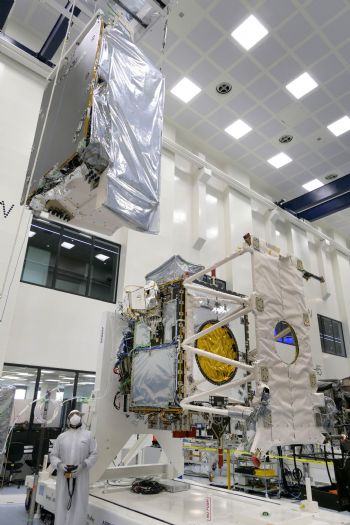
With the successful integration of the Atmospheric Lidar (ATLID), the EarthCARE satellite (Clouds Aerosols and Radiation Explorer) has passed a crucial milestone, as it concludes the "onboarding" of its three European instruments.
EarthCARE is a joint mission of the European Space Agency (ESA) and the Japanese Space Agency (JAXA), with Airbus Defence and Space in Germany acting as prime contractor to develop and build the satellite and it counterpart in France supplying the ATLID which uses laser light to study atmospheric properties.
The integration sequence has been successfully carried out and ATLID will now undergo a set of functional and performance tests which will then finally conclude the instrument delivery. The next step will be the integration of the Japanese Cloud Profiling Radar (CPR).
Once operating in orbit, EarthCARE will advance the understanding of the role that clouds and aerosols play in global climate modelling. For this EarthCARE will draw up vertical profiles of natural and man-made aerosols, register the distribution of water and ice and their transport by clouds, and provide essential input to climate models for more precise predictions of global warming.
Clouds and, to a lesser extent, aerosols reflect incident solar light back out to space, but they also trap outgoing infra-red light. This leads to a net effect of either the cooling or heating of the planet. In addition, aerosols influence the life cycle of clouds, and so contribute indirectly to their radiative effect – how much sunlight they absorb and how much they reflect back to space.
ATLID is one of four instruments of the EarthCARE satellite providing vertical profiles of aerosols and thin clouds. Operating in the UV-range at 355nm, it provides atmospheric echoes with a vertical resolution of about 100m from ground to an altitude of 20km and 500m from an altitude of 20km to 40km.
The measurement principle which was retained for ATLID uses the fact that interaction of light with molecules or aerosols leads to different spectra. ATLID is the second European lidar to be developed after Aeolus, making Airbus a world-wide specialist in space-borne lidars.
With a launch mass of 2.3 tonnes, the EarthCARE mission will be active for three years in sun-synchronous orbit at an altitude of 400km, following its Soyuz launch from French Guiana.